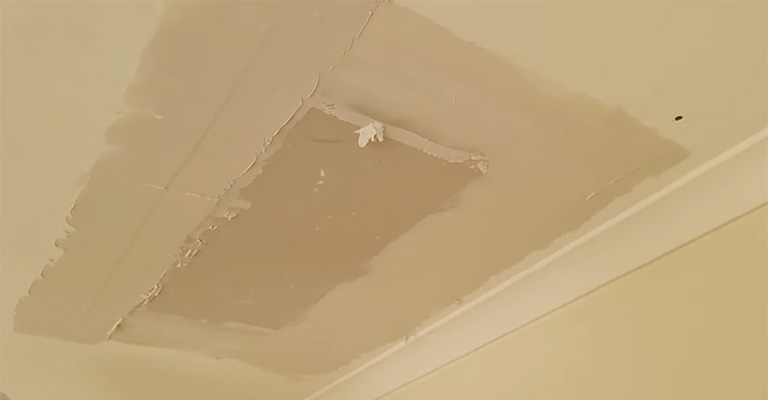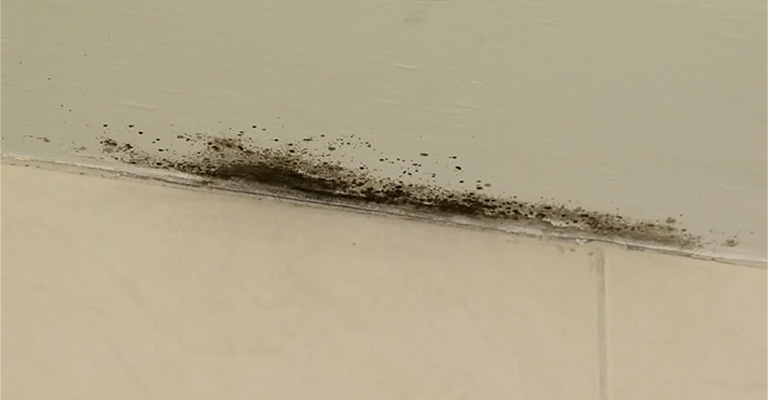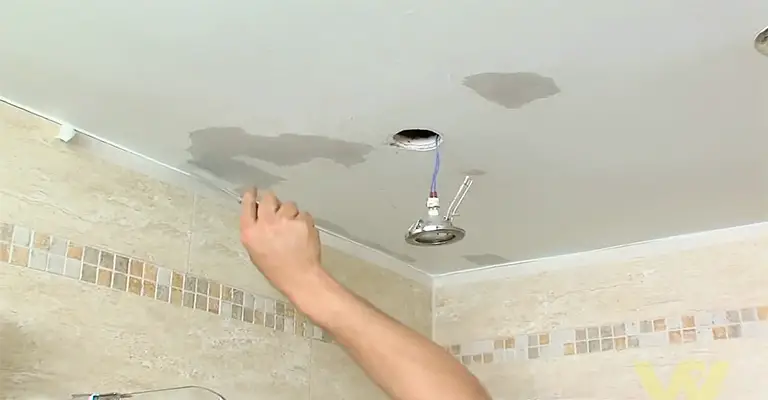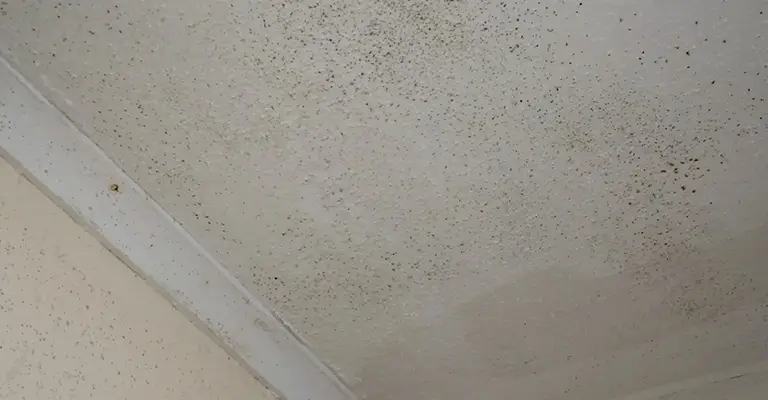Black spots on the ceiling above your shower can be a source of frustration and concern for homeowners.
These unsightly marks are often the result of mold or mildew growth, which not only detracts from the aesthetics of your bathroom but can also pose health risks if left untreated.
Dealing with black spots on the ceiling can seem daunting, but fear not, as there are effective ways to eliminate them and prevent their return.
Whenever you are in the bathroom, have you ever wondered what those black dots on the ceiling are? In most cases, mold or mildew caused this problem.
When you clean to your heart’s content, you will eventually see black dots on your ceiling or the tiles in your shower, no matter how hard you try.
Is It Mold Or Dirt?
Testing for mold usually involves a bleach test. Before painting, rinse mold and mildew with a solution of one part liquid bleach and three parts water.
Use the solution on the mildewed area and scrub it with a scrubber. You should allow the solution to sit on the surface for at least 10 minutes. Ensure that the surface is thoroughly rinsed with water and allowed to dry before painting.
Pro Tip: Wear protective eyewear, waterproof gloves, and protective clothing whenever possible.
Ensure you immediately wash off any mixture that comes into contact with your skin. You should not add detergent or ammonia to the bleach and water solution.
Depending on how things go, there can be two outcomes:
- Mold is most likely absent if the bleach solution does not turn the spot white.
- Mold is likely to be responsible if the bleach solution turns the spots white.
If It’s Not Mold
Dust, dirt, or smoke are usually the problem when mold isn’t present. Before repainting, you need to clean the dirty areas with a good household cleaner and degreaser.
If It’s Mold
You may wish to hire a specialist contractor to remedy the mold and prevent moisture from entering the walls and ceilings.
Is It Normal to Have Mold on the Bathroom Ceiling?

There is a widespread problem of mold growing on the bathroom ceiling. In some people with weakened immune systems, black mold, or Stachybotrys Chartarum, may cause serious health problems.
If you want to prevent black mold growth on your bathroom ceilings, make sure that you are reducing moisture and humidity by running a fan or opening a window after bathing and showering.
You should also clean your bathroom ceiling regularly with a bleach solution to prevent mold growth.
In addition to preventing black mold growth on your bathroom ceiling, it’s essential to take proactive measures to prevent its growth.
Why Does This Occur?
As a first attempt, it could be due to cold exterior air meeting warm, moist air inside, causing ghosting on studs and rafters where insulation is weak, especially on the interior of an outside wall or ceiling.
Moisture accumulates here more than in insulated stud wall areas and cavities. No running water is visible in this situation most of the time; it is merely water vapour.
Where condensation is found, dirt and soot tend to accumulate. As these areas get dust, airborne particles become attracted to them and build up over time. I recommend working with an insulation company to determine how best to address this issue.
Another possibility is that the area lacks moisture. It is typical for the air coming out of vents in a heated area to be dry.
A buildup of static electricity can charge dust and dirt particles, causing them to stick to walls and ceilings.
How Do You Get Rid of Mold on the Bathroom Ceiling?

You don’t need to worry if black mold grows on your bathroom ceiling. You should assess the problem’s extent before attempting to remove black mold from your bathroom ceiling.
Adding bleach to water or using other commercial cleaners can quickly solve a problem as small as mildew or mold.
Nevertheless, a deeper investigation may be necessary if the issue is more significant. Leaks in the roof, condensation on windows or pipes, poor ventilation, and plumbing issues are all common causes of water damage.
Whatever the case, it’s crucial to address the source of moisture before treating the mold itself. Thankfully, white vinegar can be used to remove black mold.
First, fill a spray bottle with white vinegar and spritz it generously over the black mold. Allow the vinegar to sit for 10-15 minutes, then use a scrub brush to thoroughly scrub the black mold off the ceiling.
Continue repeating this process until all black mold has been removed. It is also possible to replace white vinegar with water and bleach.
You should spray one part bleach and one part water onto the black mold and scrub it away with a brush.
Preventing black mold from returning is vital after it is removed. Ensure your bathroom is adequately ventilated so any moisture can completely dry out after a shower or bath.
In addition, you should address any potential leaks with water or condensation as soon as possible. If you follow these steps, you can help prevent black mold from returning and ruining your bathroom ceiling in the future.
How to Clean Mold in the Shower or Bath?

As with ceiling mold, mold can be removed from showers and baths using the same methods.
To kill the mold, use a bleach or vinegar solution after cleaning the area with a bathroom cleaner.
It is recommended that you keep the bathroom ventilated and control moisture if you wish to prevent mold from growing in the shower or bath again.
Make sure to use an exhaust fan, crack a window when showering, and squeeze any remaining moisture.
If you keep a spray bottle in the bathroom, you can avoid mold growth by spraying your bath and shower afterwards with vinegar.
Is Black Mold in the Bathroom Ceiling a Health Hazard?
It is possible for black mold in your bathroom ceiling to pose a health risk to you and your family members.
The molds of this type are usually black or greenish black in color and smell musty. Any surface containing moisture, such as walls, floors, ceilings, and pipes, can support it.
It is unsightly, and black mold can cause serious health problems if not adequately treated.
The most common symptoms associated with black mold in your bathroom ceiling include coughing, sneezing, watery eyes, nasal congestion, skin irritation, asthma, and even respiratory illness.
For this reason, if black mold is found on the ceiling of your bathroom, it is essential to seek professional help as soon as possible.
Final Words
Several factors can cause mold to grow on a ceiling, including the presence of moisture and excessive humidity.
In bathrooms, mold is often found on the ceiling when the warm, moist air of the shower or bathtub comes into contact with the cooler ceiling material. The result is condensation, which can cause mold and mildew to grow.
As well as appearing in small circles and circular patches, mold can also spread in irregularly shaped patches. The best way to remove mold depends on what kind of mold is present and how it is released.
It is important to get mold off bathroom ceilings as soon as possible to prevent it from growing and spreading.
Residents need to decrease humidity levels and increase bathroom ventilation once the bathroom ceiling mildew has been removed to prevent recurring mold growth.








